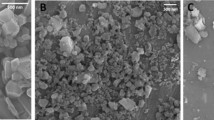Abstract
Peritoneal macrophages of Wistar rats obtained after intraperitoneal injection of mineral oil were disintegrated by repeated freezing and thawing. In response to intratracheal injection of intact rats and rats receiving four daily inhalations of titanium dioxide dust, these macrophage breakdown products (MBP) caused a substantial increase in the number of alveolar macrophages and neutrophilic leukocytes in washings from the lungs; the mean value of the neutrophil/alveolar macrophage ratio, moreover, was several times greater than in rats receiving intratracheal injections of physiological saline. The response to dust particles of low cytotoxicity plus exogenous MBP thus very closely resembled that usually observed after inhalation of a cytotoxic (quartz, for example) dust. By increasing the contribution of neutrophils to phagocytosis of inhaled particles, MBP lead to a substantial decrease in the mean dust load on the single alveolar macrophage, although the total number of phagocytosed particles is increased. Preponderant involvement of granulocytes, especially neutrophils, compared with peritoneal macrophages also was found in the peritoneal exudate of rats receiving MBP or quartz intraperitoneally, whereas injection in this way did not affect alveolar phagocytosis. MBP stimulated migration of the blood leukocytes and promoted the more efficient utilization of oxygen by the macrophages. The possible role of MBP as a factor regulating the phagocytic response of the body at various stages is discussed.
Similar content being viewed by others
Literature Cited
A. V. Bykhovskii and G. S. Komovnikova, in: The Pathogenesis of the Pneumoconioses. Proceedings of an All-Union Symposium [in Russian], Sverdlovsk (1970), pp. 341–361.
E. A. Kovalenko and L. N. Grinberg, Patol. Fiziol., No. 5, 12 (1972).
L. I. Privalova, A. V. Osipenko, and V. N. Frash, Byull. Éksp. Biol. Med., No. 12, 1480 (1976).
V. L. Skuratov, A. V. Osipenko, and V. N. Frash, Fiziol. Zh. (Ukr.), No. 1, 95 (1974).
S. I. Starikova, B. A. Katsnel'son, G. V. Aronova, et al., Byull. Éksp. Biol. Med., No. 9, 113 (1970).
I. M. Épshtein, Med. Tekhnika, No. 5, 56 (1967).
C. W. LaBelle and H. Brieger, Arch. Environ. Health,1, 423 (1960).
A. G. Heppleston, in: “Inhaled particles, III,” Proceedings of an International Symposium Organized by the British Occupational Hygiene Society, London, 1970, edited by W. H. Walton, Gresham Press, Old Woking (1971), pp. 357–369.
K. H. Kilburn, Ann. N. Y. Acad. Sci.,221, 276 (1974).
W. Klosterkotter, Beitr. Silikose-Forsch.,6, 125 (1965).
L. D. Leder, Blut,16, 86 (1967).
Rights and permissions
About this article
Cite this article
Privalova, L.I., Katsnel'son, B.A. & Osipenko, A.V. Role of macrophage breakdown products in the alveolar phagocytosis response. Bull Exp Biol Med 83, 393–396 (1977). https://doi.org/10.1007/BF00799374
Received:
Issue Date:
DOI: https://doi.org/10.1007/BF00799374




